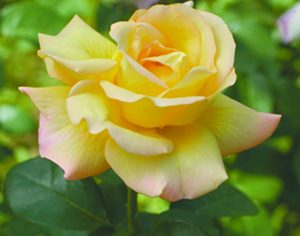June 27, 2018
Summer Care for Roses
By Richard Jauron and Willy Klein
Iowa State University Extension
Gardeners successfully grow a wide variety of roses in sunny Iowa garden areas. Iowa State University Extension and Outreach horticulturists responds to common questions related to growing and caring for roses. To have additional questions answered contact the ISU Hortline at 515-294-3108 or hortline@iastate.edu.
What is the proper way to deadhead roses?
Deadheading or the removal of faded flowers is done to encourage additional flowers on hybrid tea and other repeat-blooming roses. Hybrid tea roses usually have one or two 3-leaflet leaves immediately below the flower. Next (lower down on the stem) are two or more 5-leaflet leaves. The deadheading procedure is different for newly planted and established roses. During their first growing season, it’s usually recommended that the spent flower be removed above the uppermost 3-leaflet leaf. Removal of a larger percentage of the rose’s foliage reduces the plant’s ability to manufacture food and slows growth.
When deadheading established roses, the stem may be cut back to a 5-leaflet leaf. Retain at least two 5-leaflet leaves on each shoot. Use sharp tools (hand shears or knife) to remove faded flowers. Cut about ¼ inch above an outward facing bud and leaf with the cut made parallel to the leaf stalk.
How often should I water my roses?

Modern roses, such as hybrid teas, floribundas and grandifloras, require watering during hot, dry weather. The frequency depends on weather conditions and soil type. In most gardens, a thorough watering every seven to 10 days during dry weather is sufficient. If possible, apply the water directly to the soil around each plant. Overhead watering wets the foliage and increases disease problems. If overhead watering is unavoidable, morning is the best time to water roses. Morning applications allow the foliage to dry quickly.
An excellent way to conserve soil moisture is by mulching. Possible mulches include wood chips, shredded bark, pine needles and cocoa bean shells. Spread 2 to 4 inches of mulch around each rose or over the entire bed. Mulches also help to control weeds.
How do I prevent Japanese beetles from devouring my roses?
Japanese beetles eat the foliage, fruits and flowers of more than 300 plants. When feeding on foliage, the beetles consume the tissue between the veins, leaving a lace-like skeleton. Flowers and fruits are sometimes completely devoured. Roses, raspberries, grapevines, birches and lindens are some of their favorite food hosts.
Control of Japanese beetles is difficult because theycontinue to emerge from the ground over a period of several weeks. Handpicking is an option when small numbers of Japanese beetles are present. Remove beetles early in the morning when the temperatures are cool and the beetles are sluggish. Collect or shake beetles into a bucket of soapy water and discard.
Spot spraying plants, with insecticides, such as carbaryl (Sevin) and permethrin (Eight), should reduce the beetle population for a few days. Multiple applications will be required to maintain control as these insecticides have short residual periods. Apply insecticides in the evening and avoid spraying flowers to prevent harming bees and other pollinators.
Filed Under: Community
Trackback URL: https://www.50pluslife.com/2018/06/27/summer-care-for-roses/trackback/


